Marine Ecosystem Threats in the Persian Gulf
The Persian Gulf is a valuable water body in terms of ecosystem and biodiversity but has been affected severely due to different depleting factors. So, let’s mind its protection on April 30, Persian Gulf National Day. The day marks the anniversary of forcing out the Portuguese navy of the Strait of Hormuz in the Capture of Ormuz (1622).
The Persian Gulf has an area of about 241,000 square kilometres. Its length is some 990 km, and its width varies from a maximum of about 340 km to a minimum of 55 km in the Strait of Hormuz. It has its own environmental characteristics. It is a semi-closed sea, ageing 15,000 years, with an average depth of 35 meters, while is highly salty with severe heat fluctuations, and an annual evaporation rate of 140 cm. There are two species of dolphin and whale in the area, in addition to 1,100 species of fish and five species of turtle, the Persian Gulf also host the second largest population of manatees, 232 seaweed species and 4 million migratory birds annually, but today 240 important species and many habitats are under threat.
The Persian Gulf is one of the world’s most enclosed, small-scale marine environments. It is characterized by shallow depth and restricted water exchange with the wider Indian Ocean. The Persian Gulf represents one of the harshest marine environments in the world due to marked fluctuations in seawater temperatures and high levels of salinities. These environmental extremes may interfere with the normal functioning of marine ecosystems and affect the physiological aspects of marine organisms and their diversity, abundance and spatial distribution. The Persian Gulf hosts some of the world’s most critically endangered species, such as dugongs, green and hawksbill turtles, and supports a variety of marine ecosystems, including seagrass bed, mangroves, coral reefs and mudflats that are uniquely adapted to environmental extremes. These ecosystems are under ever-increasing pressure from anthropogenic activities that are associated with the rapid economic, social and industrial developments in the Persian Gulf countries.
The marine environment of the Persian Gulf is severely impacted. The coasts of the Persian Gulf are witnessing rapid industrialization and urbanization that contribute to the degradation of naturally stressed marine ecosystems. Coastal development associated with dredging and reclamation damages coastal and marine ecosystems. This is combined with several anthropogenic factors, including industrial and domestic effluents, brine wastewater discharges and oil pollution.
Conserving species and communities and maintaining healthy ecosystems are important priorities in the marine environment of the Persian Gulf. These could be achieved by adopting conservation approaches and management strategies that might contribute to the protection of the fragile marine ecosystems in the Persian Gulf, including marine protected areas, environmental impact assessment, environmental regulations, ecological restoration, and environmental monitoring and scientific research. Designation and implementation of marine protected areas are arguably critical for the protection of coastal and marine ecosystems in the Persian Gulf. Although several marine protected areas have been established, a lack of comprehensive management plans may hinder their effectiveness. Environmental impact assessment can play an important role in the protection of biodiversity and in the sustainable use of coastal and marine environments in the Persian Gulf. However, its effectiveness is constrained by the lack of adequate legal and regulatory frameworks, limited public participation, inadequate guidelines on procedural EIA, and lack of provisions related to cumulative impacts. Therefore, there is a need for a more strategic approach to the environmental assessment that identifies the environmental consequences of proposed policies, plans and programmes, and integrates environmental considerations into higher-level decision-making systems in the Persian Gulf.
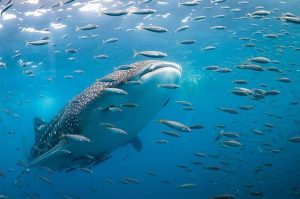
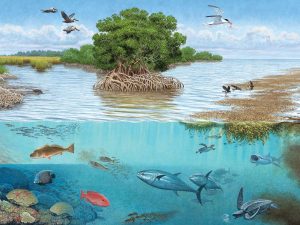
Environmental assessment is a must for artificial islands in the Persian Gulf
According to Tehran Times, construction of artificial islands off the southern coasts of the Persian Gulf must undergo environmental impact assessment to avoid negative repercussions on the ecosystem, which requires cooperation of responsible bodies, deputy Department of Environment (DOE) chief for marine affairs has said. Parvin Farshchi made the remarks on the sidelines of a meeting held on Wednesday to address environmental impacts of artificial island construction and related laws, with representatives from Ministry of Foreign Affairs, General Staff of the Armed Forces, Ports & Maritime Organization, and National Institute for Oceanography and Atmospheric Science, in attendance.
She further called on the related organizations to join hands in conducting researches for preventing the Persian Gulf from bearing man-made islands consequences, insisting on setting up a national committee for environmental impact assessment of marine environment. “A special working group also must be formed as a subcommittee to prepare researches and scientific documents for identifying how building islands leads to drying up seas,” she highlighted. She also proposed to determine particular areas in the Persian Gulf to provide new maritime transportation routes. Artificial island construction brings about many changes in the sea ecosystems, as well as shoreline erosion, change in water currents causing pollution within the islands, and an impact on marine life. High temperatures in the area also causes high evaporation rates which, coupling with desalination plants that pump extra salt and minerals into the water, increase the overall salinity of the sea. Marine life in the area have to adapt to harsh condition changes in addition to anthropogenic (human) influences like water travel and fishing.
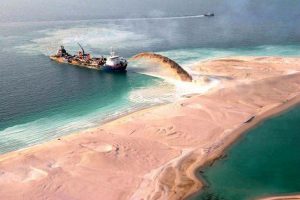
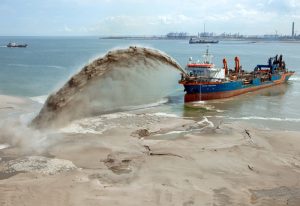
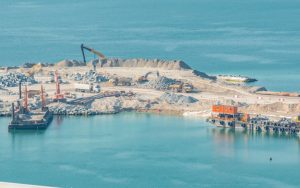
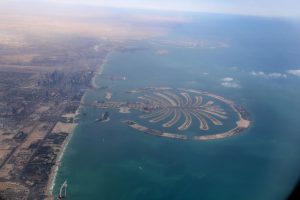
According to an academic article by Zahra Moussavi and Adeleh Aghaei , using the influence of technology, the power structures have ignored nature for the sake of protecting their interests in such a way that they have caused environmental degradation as well as the emergence of new security concerns. Meanwhile, in order to reduce oil dependence, Dubai has started the development of the tourism industry and, subsequently the construction of artificial islands in the Persian Gulf. This semi-enclosed sea with a fragile ecosystem and special climatic conditions, has suffered great environmental pressures including an increase
in temperature and salinity, degradation of marine species and disruption in the natural flow of water. Although the Convention on the Law of the Sea gives Dubai the rights to construct these islands, environmental degradation caused by such constructions and ignoring other countries’ rights are contrary to this Convention’s provisions. In order to maintain environmental security, policymakers need to understand that we live in an era in which security issues have turned into environmental security and given that the environment is an integrated concept, the interests and threats of all countries are interwoven.
Geopolitical and environmental study of artificial islands in the Persian Gulf (from the perspective of international law)
Constructing Artificial Islands from the Viewpoint of Kuwait Convention, 1978 (ROPMI)
Iran, Bahrain, Qatar, Iraq, Kuwait, Oman, Saudi Arabia, and the United Arab Emirates are the states which have concluded“Kuwait Regional Convention for Cooperation on the Protection of the Marine Environment from Pollution” and subsequently established “the Regional Organization for the Protection of the Marine Environment (ROPME)”. The Kuwait Convention (1978)declares that the Persian Gulf is of the special regions and takes some measures to protect the regional natural ecosystem by excluding the mentioned Convention and the Additional Protocols (Lebensraum definition, 2010). In the introduction to the convention, the parties undertake to observe the following goals:
1. Mindful of the special hydrographic and ecological characteristics of the marine environment of the region and its particular vulnerability to pollution, and Conscious of the need to ensure that the processes of urban and rural development and resultant land use should be carried out in such a manner as to preserve, as far as possible, marine resources and coastal amenities and that such development should not lead to deterioration of the marine environment.
2. Convinced of the need to ensure that the processes of industrial development should not, in any way, cause damage to the region’s marine environment, jeopardize its living resources or create hazards to human health.
3. Recognizing the need to develop an integrated management approach to the use of the marine environment and the coastal areas, which will allow the achievement of environmental and development goals in a harmonious manner. According to article 3 of the Convention, the contracting states undertake to, jointly or individually, take necessary measures referred in this Convention and the protocols in force to which they are a party to prevent, abate and combat environmental pollution of the sea area. Also, the contracting states shall cooperate with the competent international, regional and sub-regional organizations to establish and adopt regional standards, recommended practices and procedures to prevent, abate and combat pollution from all sources in conformity with the objectives of the present Convention, and to assist each other in fulfilling their obligations under the present Convention. (ROPME publication, 2002) Article 13 of the Kuwait Convention, like Article 235 of the Convention on the Law of the Sea, defines a general obligation to formulate regulations as to the liability and compensation of the contracting states. According to this article: “the contracting states undertake to co-operate in the formulation and adoption of appropriate rules and procedure for the determination of:
1. civil liability and compensation for damage resulting from pollution of the marine environment, bearing in mind applicable international rules and procedures relating to those matters; and
2. liability and compensation for damage resulting from violation of obligations under the present Convention and its protocols.The Convention prescribes two types of legal liability: A) liability resulting from the violation of international regulations, B) liability resulting from violation of obligations under this Convention and its protocols.Under these conditions, the states constructing artificial islands in the Persian Gulf, besides the regulations set in the Convention on the Law of the Sea, should respect regional regulations. Based on this Convention, the constructing states are responsible for any damage to the environment, and in case of any damage to the region or the neighbouring states, they are obliged to compensate it while accepting its liability. Moreover, before taking any action, they are obliged toreview the environmental consequences. However, the present evidence and documents show that the constructing states do not consider environmental regulations and public rights in constructing the islands.
Consequences of Constructing Artificial Islands in the Persian Gulf and the Gulf of Oman.
The Convention on the Law of the Sea (1982) has a special emphasis on the necessity of considering the marine environment in the construction of artificial islands. Based on this Convention, the required condition in constructing artificial islands is not to cause damage to the environment and living and non-living resources on the seabed and under the seas (article 235, 1982 Convention)(ROPME publication, 2003). The considerations to be observed during construction are water deepness, weather, the amplitude of the biggest wave, tidal amplitude, marine currents, conditions of the building foundation, earthquake risk, sources of materials, shipping lane, existing pipelines, legal aspects, environmental considerations, and fishing considerations. Failing to observe these principles results in environmental challenges and problems. Legal findings show that article 56 of the Convention on the Law of the Sea (1982) permits governments to construct artificial islands. However, these islands should not interfere with international navigation. More importantly, the islands do not have natural or marine territories and have no effect on defining the limits of the territorial sea (Churchill & Lu, 1988).
Constructing artificial islands certainly have positive and negative consequences. The positive consequences are that the Persian Gulf can be changed into a peace and economic gulf and as a result there is flourishing of tourist, political and economic activities. Also, it causes political stability. Since Arab investment for these islands is long-term and huge, they cannot do anything against the interests of states in the region to not endanger their economic and tourist interests. Thus, theislands can help to grow regional economy and cooperation. However, these constructions have negative impacts, too.Generally, the Persian Gulf is a region with special and fragile environmental conditions. Each 4 to 5 years, its water changes and any changes in the form of the sea will have unpleasant impacts on all coastal states. During last years, environmental pollution has been caused by human activities and irregular exploitation. Water pollution is a big part of environmental pollution. In these conditions, it seems important to analyze political and environmental effects of this issue because any ignorance in pursuing the case can endanger national interests of the state. Currently, the United Arab Emirates has control over 60 Km2 of the Persian Gulf islands, and according to Sultan bin Salim, manager of the World Island project, this projectadds 1200 Km to the island’s area of the United Arab Emirates.
Constructing these islands not only results in decomposition ofthe environment but also causes geopolitical changes in the Persian Gulf. Therefore, the power of Arab in defining bordersand controlling the sea will be increased. Totally, it can be said that non-coastal states do not have the right to construct artificialislands in the Persian Gulf. Constructing artificial islands result in increase of water turbidity, burial and suffocation of thewildlife, change and transportation of coastal sediments, and transforming sands into a swamp. Due to political pressures andlegal excavations, the constructing company has ignored the environmental laws and constructed the islands on the corals.Increase of Arab states’ share (twenty fold increase of the coasts), their claim for more rights, and increase of their dominance over the Persian Gulf are other resulting problems due to these plans which will be intensified in future. The bed of the PersianGulf near Dubai coasts are mainly constitutes of sands and non-adhesive and loose sediments. Sea infant cannot live on thesenon-adhesive sediments which cover the entire hard seabed. The sludge will increase water darkness, create a lot of swampsand affect the species. The pattern of tidal currents will also be changed. There will be an extreme deposition behind the island which will change the pattern of currents. Waste waters will increase and these conditions will worsen the life situation of plantsand animals. The United Arab Emirates Diving Association has criticized that Jumeirah Island has been polluted this island with a grey, mortar- and silt-form material. The region of Jebel Ali Island is on the wildlife part of Jebel Ali and has impacted on the second rich habitat of the Persian Gulf.According to the Convention on the Law of the Sea, coastal states can construct artificial islands in the waters under their control, but they should consider environmental programs and the mutual interests of the marine neighbours, otherwise, these constructions are not acceptable from the International Law viewpoint. Therefore, due to the destructive environmental impacts of Emirates artificial islands, these islands have the least compatibility with the marine environment and interests ofthe states.
According to these facts, the research hypothesis that constructing artificial islands is not compatiblewith environment and destructs the environmental conditions of the region is proved. Therefore, the legitimacy of these islands is considered to be a serious challenge.1- The expert studies indicate that constructing artificial islands impacts the general circulation in the Persian Gulf and will have long-term and serious effects on it, the effects which have more serious impacts on the morphology of the coasts.2- The pattern of ebb tides in the Persian Gulf, the impact of which is usually on the northern coasts of the Persian Gulf (Iran),and of the flood tides, the impact of which is usually on the southern coasts of the Persian Gulf (Emirates), has changed. More detailed analysis of this case requires a mathematical model.3- Deposition behind the Emirates artificial islands, apart from adding thousands of hectares to the coastal lands, will increase the nutrition of shorelines in the areas located after the artificial islands (eastern Emirates), which is near the Hurmoz Strait.The resulting changes together with the impact of the sea waves should be seriously reviewed.4- The effects of geology, sedimentology (deposition – erosion), sediment hydraulics, natural filtration of the coastal sediments,environment, ecosystem, fisheries, seabed changes, marine corals, marine biology, law of the seas, … should be seriously reviewed in separate studies.According to the report by the experts of international monitoring organizations, the primary consequences of obvious manipulation in nature include:1- The sole recognized coral coast has been destructed during this operation.2- Coastal nests of the sea turtles, “of the special species of the Persian Gulf region”, have been destructed.3- Natural water currents have changed their route.4- The resulting sludge of this operation has changed the limpid waters into a swamp within the limits of artificial islands and this process is advancing.While the Persian Gulf coastal states have not yet shown any effective reaction in this regard, the second project has been started. Even more than that, by constructing an artificial park under the sea for divers, they have evidently violated the international laws of the seabed. Moreover, the regional ecosystem and most of coastal corals have been destroyed. But, themain disaster of this project, which is at its first steps of the process, is that it totally destroys about 63 Km2 of the Persian Gulf ecosystem and, if the project be completed, it should be said “good bye the Persian Gulf”.
Also, generating the pollutions and not protecting the Persian Gulf environment against explorations, excavations, and pollution of regional organizations areother consequences of this project, and more regrettable is that such states as Kuwait and Bahrain have recently declared that they also have similar plans to construct artificial islands. Changes of the sea level on universal and local scale have a considerable role in changing the shoreline. These changes result from the climate, sea surface temperature, wind speed and moisture which control water density, which depends on the evaporation rate. The Persian Gulf with an average depth of 42 m is also affected by these factors.
1- Marine currents: the invasion of seasonal unstable waters from the Indian Ocean to the Persian Gulf causes the sea level to rise. During seasonal changes, sea-level fluctuations impact on the coasts and change the sea level. When waves reach the coast, wave breaking causes the sediment grains to move from one part to another. Therefore, any obstacle in the Persian Gulf prevents sediment transportation and as a result they deposit there and current lines change. The speed of sea current has had a great impact on the amount of sediments being transported and for years, the currents lift up the sediments and transport them to another place. Constructing Emirates artificial islands with various lengths and shapes impacts on the natural cycle of tidal currents, which is the source of natural purity of water. The pattern of sea currents in Iranian coasts and Qeshm Abu Musa, Greater and Lesser Tunbs and Siri islands, and even, to some extent, the entering and leaving currents of the HurmozStrait will be changed in the long term which will result in serious changes of the regional ecosystem and probably will even transport Avicennia marina forests and coastal and marine trees.
2- Wind: the wind direction in the Persian Gulf is mostly NW and has more winter intensity than summer. Therefore,in winter, the Persian Gulf is under the pressure of more air due to the winds on the surface of water, which affects the sea level. Constructing these islands also impacts the wind-generated currents, the pattern of which should be studied by mathematical models.
3- Density: at the far end of the northern Persian Gulf, in winter, the water density is more compared to the southern and western parts of the Gulf. Along the southern and western shorelines, due to more moderation of the climate in winter and high rate of evaporation, water salinity is higher and this amount of salinity is considered to be a controlling factor in transportation of sediments. The obstacles created by constructing artificial islands in the Persian Gulf can affect the water cycle and even change the pattern of density currents.

